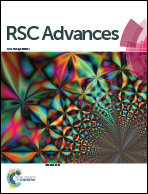Preparation of thiol-functionalized magnetic sawdust composites as an adsorbent to remove heavy metal ions†
Abstract
Thiol-functionalized magnetic sawdust, synthesized by precipitating γ-Fe2O3 nanoparticles on the sawdust surface and then modifying the 3-mercaptopropyltrimethoxysilane layers, has been investigated as an environmentally friendly and recyclable adsorbent for heavy metal ions. The process of modifying was confirmed by scanning electron microscopy, Fourier transform infrared spectroscopy, X-ray photoelectron spectroscopy and X-ray diffraction. Compared with the nonmagnetic sawdust, the thiol-functionalized magnetic sawdust possesses high saturation magnetization (7.28 emu g−1), and can be easier and faster to separate from water under an external magnetic field. The adsorption equilibrium was reached within 20 min and the adsorption kinetics were elucidated by a pseudo-second-order model. The adsorption isotherms of Cu2+, Pb2+ and Cd2+ fitted well with the Langmuir model, exhibiting an adsorption capacity of 5.49 mg g−1, 12.5 mg g−1 and 3.80 mg g−1, respectively. Competitive adsorption among the three metal ions showed a preferential adsorption of Pb2+ > Cu2+ > Cd2+. In addition, the magnetic sawdust adsorbent exhibited excellent acid–alkali stability and the metal-loaded adsorbent was able to regenerate in an acid solution without significant adsorption capacity loss.


 Please wait while we load your content...
Please wait while we load your content...